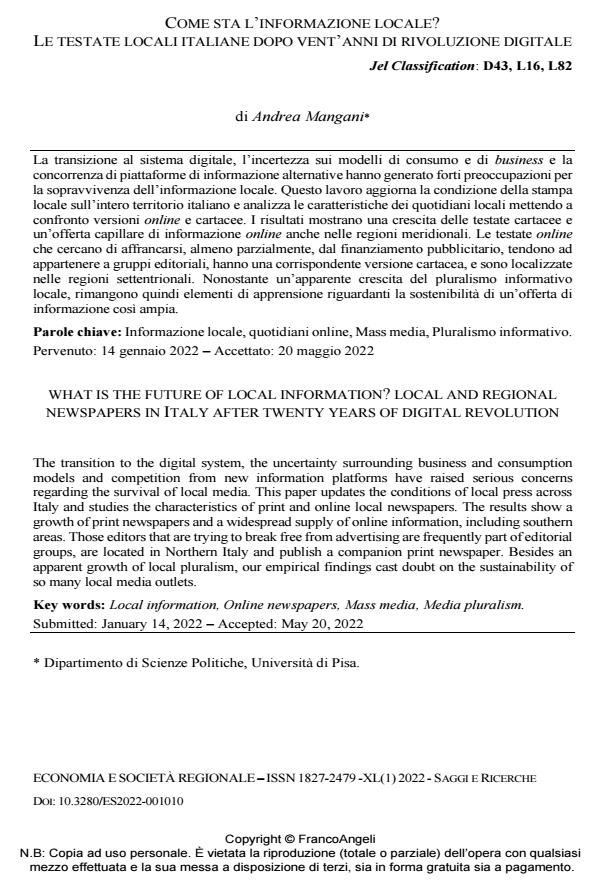Come sta l’informazione locale? Le testate locali italiane dopo vent’anni di rivoluzione digitale
Titolo Rivista ECONOMIA E SOCIETÀ REGIONALE
Autori/Curatori Andrea Mangani
Anno di pubblicazione 2022 Fascicolo 2022/1
Lingua Italiano Numero pagine 19 P. 126-144 Dimensione file 327 KB
DOI 10.3280/ES2022-001010
Il DOI è il codice a barre della proprietà intellettuale: per saperne di più
clicca qui
Qui sotto puoi vedere in anteprima la prima pagina di questo articolo.
Se questo articolo ti interessa, lo puoi acquistare (e scaricare in formato pdf) seguendo le facili indicazioni per acquistare il download credit. Acquista Download Credits per scaricare questo Articolo in formato PDF

FrancoAngeli è membro della Publishers International Linking Association, Inc (PILA)associazione indipendente e non profit per facilitare (attraverso i servizi tecnologici implementati da CrossRef.org) l’accesso degli studiosi ai contenuti digitali nelle pubblicazioni professionali e scientifiche
La transizione al sistema digitale, l’incertezza sui modelli di consumo e di business e la concorrenza di piattaforme di informazione alternative hanno generato forti preoccupazioni per la sopravvivenza dell’informazione locale. Questo lavoro aggiorna la condizione della stampa locale sull’intero territorio italiano e analizza le caratteristiche dei quotidiani locali mettendo a confronto versioni online e cartacee. I risultati mostrano una crescita delle testate cartacee e un’offerta capillare di informazione online anche nelle regioni meridionali. Le testate online che cercano di affrancarsi, almeno parzialmente, dal finanziamento pubblicitario, tendono ad appartenere a gruppi editoriali, hanno una corrispondente versione cartacea, e sono localizzate nelle regioni settentrionali. Nonostante un’apparente crescita del pluralismo informativo locale, rimangono quindi elementi di apprensione riguardanti la sostenibilità di un’offerta di informazione così ampia.
Parole chiave:Informazione locale, quotidiani online, Mass media, Pluralismo informativo. Pervenuto: 14 gennaio 2022 - Accettato: 20 maggio 2022
Andrea Mangani, Come sta l’informazione locale? Le testate locali italiane dopo vent’anni di rivoluzione digitale in "ECONOMIA E SOCIETÀ REGIONALE " 1/2022, pp 126-144, DOI: 10.3280/ES2022-001010